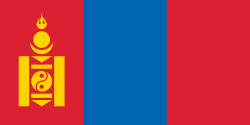Dsawchan-Aimag
| Dsawchan-Aimag Завхан Аймаг | |
|---|---|
 Wappen des Dsawchan-Aimag |  Flagge des Dsawchan-Aimag |
 Der See Char Nuur im Dsawchan-Aimag | |
| Gegründet: | 1931 |
| Hauptort: | Uliastai |
| Fläche: | 82.500 km² |
| Einwohner: | 89.999 (2000) |
| Bev.-dichte: | 1,09 Einw./km² |
| Telefonvorwahl: | +976 (0)146 |
| KFZ-Kennzeichen: | ЗА_ |
| ISO 3166-2: | MN-057 |
| Offiz. Website: | zavkhan.gov.mn |
| Lage des Dsawchan-Aimag in der Mongolei | |
Koordinaten: 47° 48′ N, 96° 48′ O
Der Dsawchan-Aimag (mongolisch Завхан Аймаг) ist ein Aimag (Provinz) der Mongolei, im Nordwesten des Landes gelegen.
Administrative Gliederung
| Sum | Mongolisch | Bevölkerung[1] (2005) |
|---|---|---|
| Aldarchaan | Алдархаан | 3.708 |
| Asgat | Асгат | 1.125 |
| Bajanchairchan | Баянхайрхан | 1.968 |
| Bajantes | Баянтэс | 3.024 |
| Dörwöldschin | Дөрвөлжин | 2.323 |
| Erdene-chairchan | Эрдэнэ-хайрхан | 1.771 |
| Ich-Uul | Их-Уул | 6.271 |
| Ider | Идэр | 2.714 |
| Jaruu | Яруу | 2.547 |
| Nömrög | Нөмрөг | 1.848 |
| Otgon | Отгон | 3.478 |
| Santmargats | Сантмаргац | 2.101 |
| Schilüüstei | Шилүүстэй | 2.450 |
| Songino | Сонгино | 1.921 |
| Telmen | Тэлмэн | 2.820 |
| Tes | Тэс | 3.230 |
| Tosontsengel | Тосонцэнгэл | 9.045 |
| Tsagaanchairchan | Цагаанхайрхан | 1.823 |
| Tsagaantschuluut | Цагаанчулуут | 1.496 |
| Tsetsen-Uul | Цэцэн-Уул | 2.114 |
| Tudewtei | Түдэвтэй | 2.003 |
| Urgamal | Ургамал | 1.822 |
| Dsawchanmandal | Завханмандал | 1.324 |
Persönlichkeiten
- Söhne und Töchter der Aimag (Provinz)
- Punsalmaagiin Otschirbat (* 1942), erster Staatspräsident der Mongolei (1990–1997).
- Natsagiin Bagabandi (* 1950), zweiter Staatspräsident der Mongolei (1997–2005).
- Schagdariin Otgonbileg (* 1952), Vorstandsvorsitzender des mongolischen Bergwerksunternehmen Erdenet Mining Corporation.
- Begdsiin Jawuuchulan (1929–1982), mongolischer Schriftsteller.
- Namdschilyn Bajarsaichan (* 1965), ehemaliger mongolischer Boxer.
Weblinks
- Michael Martin: Ritt zu den Mongolen. In: Spiegel Online. 14. Juni 2019.
Einzelnachweise
- ↑ Сумдын Танилцуулга. Dsawchan-Aimag, archiviert vom Original am 1. November 2008; abgerufen am 14. Juni 2019 („Introduction to the Sums“).
Auf dieser Seite verwendete Medien
Autor/Urheber: TUBS
Lage des Aimags XY (siehe Dateiname) in der Mongolei.
(c) English Wikipedia Benutzer Bogomolov.PL, CC BY-SA 3.0
Map of the Zavkhan aimag with the sums
Coat of Arms of Zavkhan Aimag in Mongolia
No official blason found.
- A cross-vajra, symbol of steadyness
- Otgontenger Mountain with its snow cap
- A strip of each sand color, green, blue, and brown
- Two white flowers with yellow center
Flag of Zavkhan Aimag.
COA inset is the version in use since about 2013. The same flag is sometimes also seen without the inset.
No official blason found.Image caption and information available at [1]
Khar Nuur, or the Black Lake, is located in western Mongolia's Valley of Lakes, part of a system of closed basins stretching across central Asia. These basins are the remnants of larger paleolakes (paleo- means "ancient") that began to shrink approximately 5,000 years ago as regional climate became drier. Like other lakes in the region, Khar Nuur relies on precipitation, growing in the spring and shrinking in the summer. This process of growth and shrinkage produces a variety of wetland habitats, as well as resting points for large numbers of migratory birds.
This photograph captures the dynamic nature of the landscape of Khar Nuur. The lake is encircled by sand dune fields that encroach on the lower slopes of the Tovkhosh Mountains to the west and south. Gaps in the mountains have been exploited by sand dunes moving eastward, indicating westerly winds. The most striking example is a series of dunes entering Khar Nuur along its southwestern shoreline. Here, the dunes reflect the channeling of winds through the break in the mountain ridgeline, leading to dune crests lying perpendicular to northwesterly winds. Another well-developed line of dunes appears between Khar and Baga Lakes; while these dunes appear to cut across a lake surface, the dunes have in fact moved across a narrow stream channel.
This image was acquired Sept. 7, 2006, by the crew of the International Space Station
Kodak 760C digital camera using a 400 mm lens, [1]
Image credit: NASA







